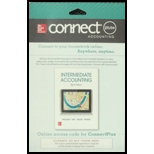
Nonmonetary Exchange
Exchange of non-monetary assets for another non-monetary asset is known as nonmonetary exchange.
Exchange has commercial substance:
If an exchange (Example: exchange of land for another non-monetary asset other than land) is likely to have a change in the future
Exchange lacks commercial substance:
If an exchange (Example: exchange of land for another land) is expected that it will not change the future cash flows, then such exchange is known as exchange lacks commercial substance. In this case, an exchange lacks commercial substance; therefore new non-monetary asset would be value at the book value of the old non-monetary asset.
To determine: The fair value of the truck received.
Want to see the full answer?
Check out a sample textbook solution
Chapter 10 Solutions
INTERMEDIATE ACCT.-CONNECT PLUS ACCESS
- How much total cost would be allocated to the Assembly activity cost pool?arrow_forwardDo fast solve this questionarrow_forwardSuppose a stock had an initial price of $66 per share, paid a dividend of $1.8 per share during the year, and had an ending share price of $80. Compute the percentage of total return. a. 23.94% b. 19.75% c. 29.70% d. 25.14%arrow_forward
- Accounting answer with solutionarrow_forwardAccounting answer with correct solutionarrow_forwardValley Tech Inc. reported the following balances at the end of the year: Credit Sales: $250,000 Accounts Receivable: $45,000 Allowance for Uncollectible Accounts before adjustment: $2,000 debit Valley Tech estimates that 5% of the credit sales will be uncollectible. What is the net realizable value of accounts receivable after the year-end adjustment?arrow_forward
- XYZ Co. has an average collection period of 45 days. Total credit sales for the year were $3,200,000. What is the balance in accounts receivable at year-end? (Use 360 days in a year. Round to the nearest dollar.)arrow_forwardProvide Answerarrow_forwardCompute the percentage of total return?arrow_forward
- Compute the net incomearrow_forwardPlease explain the solution to this general accounting problem using the correct accounting principles.arrow_forwardProperty, Plant & Equipment (Non-current Assets) 1.Define PPE and explain its treatment under IAS 16.2.Compare the cost model vs. revaluation model, including pros, cons, and theoretical implications (e.g., relevance vs. reliability).3.Calculate depreciation using both straight-line and reducing balance methods for an asset costing $500,000 with an expected life of 10 years and residual value of $50,000.4.Explain how impairment and disposals affect PPE reporting and financial results.arrow_forward

 AccountingAccountingISBN:9781337272094Author:WARREN, Carl S., Reeve, James M., Duchac, Jonathan E.Publisher:Cengage Learning,
AccountingAccountingISBN:9781337272094Author:WARREN, Carl S., Reeve, James M., Duchac, Jonathan E.Publisher:Cengage Learning, Accounting Information SystemsAccountingISBN:9781337619202Author:Hall, James A.Publisher:Cengage Learning,
Accounting Information SystemsAccountingISBN:9781337619202Author:Hall, James A.Publisher:Cengage Learning, Horngren's Cost Accounting: A Managerial Emphasis...AccountingISBN:9780134475585Author:Srikant M. Datar, Madhav V. RajanPublisher:PEARSON
Horngren's Cost Accounting: A Managerial Emphasis...AccountingISBN:9780134475585Author:Srikant M. Datar, Madhav V. RajanPublisher:PEARSON Intermediate AccountingAccountingISBN:9781259722660Author:J. David Spiceland, Mark W. Nelson, Wayne M ThomasPublisher:McGraw-Hill Education
Intermediate AccountingAccountingISBN:9781259722660Author:J. David Spiceland, Mark W. Nelson, Wayne M ThomasPublisher:McGraw-Hill Education Financial and Managerial AccountingAccountingISBN:9781259726705Author:John J Wild, Ken W. Shaw, Barbara Chiappetta Fundamental Accounting PrinciplesPublisher:McGraw-Hill Education
Financial and Managerial AccountingAccountingISBN:9781259726705Author:John J Wild, Ken W. Shaw, Barbara Chiappetta Fundamental Accounting PrinciplesPublisher:McGraw-Hill Education





